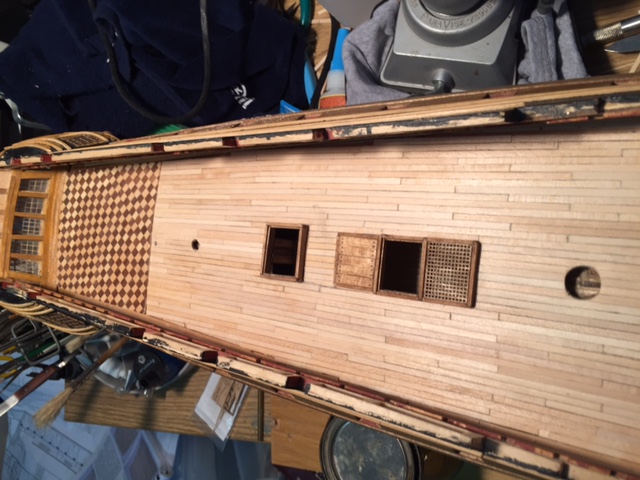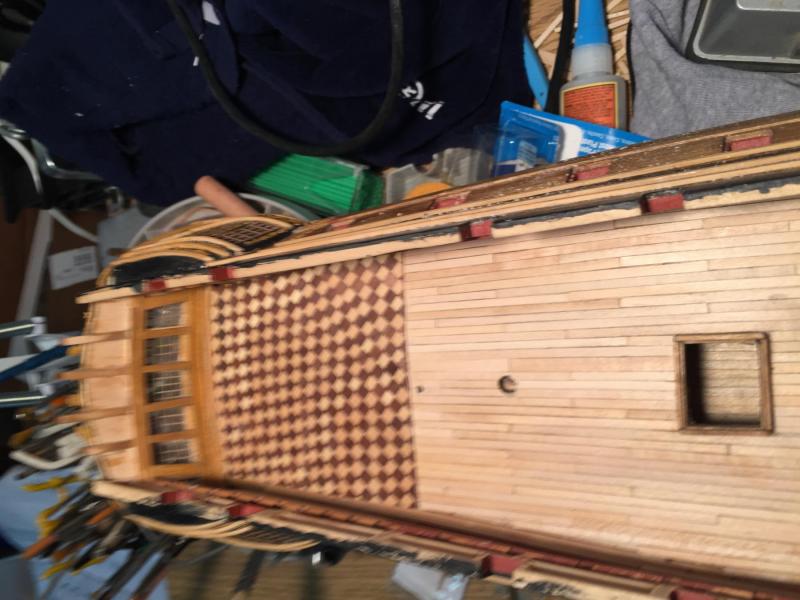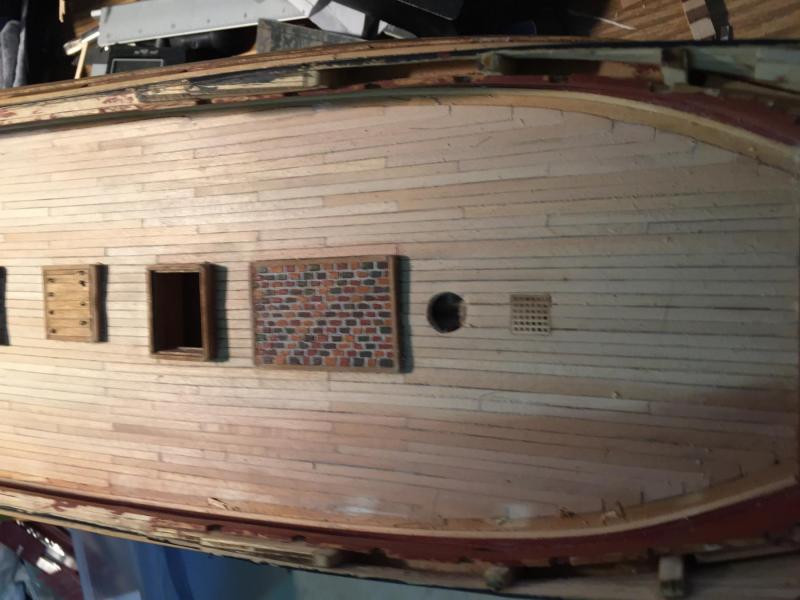-
Posts
327 -
Joined
-
Last visited
Content Type
Profiles
Forums
Gallery
Events
Posts posted by Jaxboat
-
-
Pet peeve of mine: Floquil paints are not "acetone based" and Acrylics are not "water based". In both cases the water and acetone are in the case of the Floquil, solvents for the paint polymer vehicle or, in the case of Acrylics, they are water borne i.e. they are suspended in the water by various means but not soluble in the water(acrylic paint vehicles have little or no water solubility depending on their acrylic polymer's composition). There are acrylic paint vehicles that are soluble in the appropriate solvent blend (KRYLON spray paints for example). Some acrylic vehicles have partial solubility in water alcohol mixes which is how acrylic water borne hobby paints develop good flow and level properties.
Best
Jaxboat
- Canute, BETAQDAVE, Ryland Craze and 2 others
-
 5
5
-
-
Great job on the staircases. Quite a chore
Best Jaxboat
- mtaylor, piratepete007 and marktiedens
-
 3
3
-
Thanks. Love Swiss pear but the decks already installed unfortunately. Did the Tung oil add additional color and perhaps a little sheen or gloss?
Short story: I was a Chemical sales trainee for Rohm and Haas Company in Phila. R&H created many of the acrylic emulsions that made water borne coatings possible. Part of my job was to answer technical questions from current or potential customers. We had a very experienced Customer service and formulation Lab Chemist that I was supposed to copy with my letter responses (no internet in those days). The guy was brilliant and also had a penchant for really bad puns. One day, I got a letter from a client who was having lapping problems with his acrylic house paint based on our emulsions. I don't know what made me do it, but I ginned up a dummy letter to the client that I only sent to my immediate superior and the bad pun chemist. The letter told the customer to solve his lapping issues by adding a little "tongue oil". I actually called the client with the real solution to the problem. My boss thought the letter was hilarious. Then he received a call from the irate punster chemist saying tongue oil would worsen the problem not solve it. My boss almost had a fit from laughing which only incensed the punster more. Finally my boss told the guy to read the tongue oil part carefully. Fortunately when he realized my joke, he loved it and told the story for years
-
Moonbug
How wonderful of you to finish Augie's Confederacy. You did a first rate job. I am working on my own Confederacy and have a question. What finish did you or Augie use on the deck? I love the warm color. Is from the finish, a wood upgrade or both. Any help greatly appreciated.
Best
Jaxboat
-
Good well designed (accuracy, plans etc) basic kits that can be upgraded with better wood, resin figures and parts instead of terrible castings. Your Confederacy (my current build) is a good role model. Good plans that even a one or 2 kit person can put together with close attention to plans. Bought your resin figure head to replace "Marvin the Martian" as well as your cannons and now "rope". Modellers Shipyard in Aus has put out a series of kits at various price points where you can buy a CD of their Model expert actually building the model. I have learned lots from them such as how to do copper plating.
Best
Jaxboat
- John Allen, hollowneck, Canute and 1 other
-
 4
4
-
You can use a number of metal powders. Cast bronze decorative copies of famous statues are made that way. The metal powder do weaken the strength of molded part but look great. I have no idea what the mix ratio of resin to bronze powder is.
-
OK Being a tad OCD. I decided to do a survey of the mustards in our fridge. I recently took upp gourmet cooking so I had quite a few to choose from. Here is my List: Domaine des Vignes Origin France, white wine vinegar and distilled vinegar (Druxey's acetic acid) sugar and citric acid (weak acid propably with some preservative role
Maille Honey Dijon: French, vinegar, citric acid and Potassium meta bisulfite (lumped together as acidifiers)
French's classic yellow: US Awesome hot dog ("tube Steak") mustard, distilled vinegar, Tumeric and paprika and other spices. Interestingly the yellow color come from their spice blend
Publix honey mustard : super market generic US, About the same except they use cider vinegar in addition to distilled.
Conclusions
Nothing obvious. Vinegar is always the second largest ingredient
Nothing extraordinary pops out except the use of acids to maintain a low pH.
Maybe the answer is in the ground mustard seed which is the third highest wt ingredient
You need to conduct some "wet" chemical experiments
Jaxboat
- michael mott, BANYAN and druxey
-
 3
3
-
-
Hi Chris,
Any update on your Victory release date? Hope all is well with you and your canine apprentices
Jaxboat
- WackoWolf, Richardjjs, mtaylor and 5 others
-
 8
8
-
Have not tried it but reviewed info available from internet. Tung oil is a seed oil. It has been used in coatings for centuries in China. The dark form is a mixture of tung oil and gilsonite which I believe is an asphalt of some kind. . The supplier sells a version with 3 dipentene solvent to cut viscosity. I recommend you review the SDS (safety data sheet) for product before using especially safe handling and protective gear. Terpene solvents are also quite flammable. You can find more info on the constituents by googling the list CAS numbers. Pure tung oil dries through oxidation like linseed oil darkens with age but at a slower rate than linseed oil. asphalt also oxidizes but I could not find any info on its impact on that property either positive or negative. My educated guess is that it is substantially less oxidatively stable than pure tung
Jaxboat
- mtaylor, Canute, Landlocked123 and 1 other
-
 4
4
-
I agree Druxey. I once lived in a converted 225 year old converted Barn. The builders cut all the beams (old growth white oak, hickory and Chestnut) in the fall and put them in the farm pond. In the spring they raised the water logged beams wet. During the summer the beams dried and shrunk rock hard. Then they put the exterior planking on. It was almost impossible to drive a nail into the beams.
Jaxboat
-
- GrandpaPhil and Tadeusz43
-
 2
2
-
Solvent based contact cement will work for copper plates but there are two disadvantages. First, the solvent is way bad for you and second the cement will ultimately oxidize and fail. I suggest using super glue. A small drop in the center will do. You should also make sure you have good ventilation with super glue. Modellers Shipyard (Australia) has a very good DVD on how to apply copper plates. Well worth the cost.
- mtaylor, thibaultron, Roger Pellett and 1 other
-
 4
4
-
Modellers Shipyard (Aus) have excellent construction videos. Their plans usually suffer because they appear to be Xeroxed a million times and are hard to read at times. Chuck's kit plans are awesome. Bob Hunt's kits also have excellent instructions and photos. Jotika has excellent plans especially for their Nelson series. Victory models also have excellent plans.
Best
Jaxboat
- mtaylor, Canute, thibaultron and 1 other
-
 4
4
-
I use various techniques including: alcohol (IPA > 90%), very fine sanding. 0000steel wool with alcohol. Scraping, etc. Pre-staining, sealing etc. is a great help.
I will try alcohol wipes, intriguing idea.
Jaxboat
- Canute, thibaultron and mtaylor
-
 3
3
-
Best of luck in your new venture!
Jaxboat
- Daniel Dusek, Altduck, Canute and 2 others
-
 5
5
-
I am curious could you just do this with a flexi file, miniature diamond files, mini chisels and Squadron files?
- Saburo, Elijah, thibaultron and 3 others
-
 6
6
-
OK: Elements of a paint used in modeling:
"Oil Based: Enamels Pigment, binder (drying (oxidizing) oils such as linseed oil, alkyds made from soybean oil, tall oil from paper manufacture etc "cooked" (reacted), diluents to reduce viscosity (terps, etc.), drying agents (organo (manganese, zinc etc) metallic complexes to speed oxidation i.e. drying). Enamels
Solvent borne: lacquers (low molecular wt, acrylic resins, styrene copolymers, nitrocellulose etc) resins solved in carrier solvent such as ketones aromatics (xylene etc). Paint dries as solvent evaporates, pigments. Can be re-dissolved in original or alternate solvent blends
Water borne: Binders including acrylic emulsion, acrylic dispersion, styrene acrylic emulsion, urethane pre-polymers and resin dispersions, etc , pigments dispersants to disperse, suspend and disaggregate pigments. Can be binder resins or separate. Coalescent agents (Co-solvents) to aid film formation, defoamers, viscosity and rheology modifiers and many others.Pigments, (metallic pigments are unique to WB)
Water borne paints are much more complex than solvent or drying oil based because of the poor surface tension (wetting) properties of water The terms lacquer and enamel are really not germane. I guess you could term a floor polish a lacquer. Inability to re-dissolve an acrylic house paint emulsion is a function of high molecular weight of the acrylic emulsion not composition.
- Canute, FatFingers, druxey and 1 other
-
 4
4
-
I believe iron oxide reds were the right choice. If nothing else, they are extremely color stable. Organic reds on the other hand are much less stable. There is no such thing as an acrylic red. There are acrylic paints containing red pigments. Interesting discussion.
- druxey, Canute, Chuck Seiler and 1 other
-
 4
4
-
Doh! As Homer would say. See it now. Sorry!!
- mtaylor, Canute and thibaultron
-
 3
3
-
Hi Chuck,
Where on the site will this be posted
Jaxboat
- Canute, thibaultron and mtaylor
-
 3
3
-
-






USS Kearsarge BlueJacket Shipcrafters Kit
in Wood ship model kits
Posted
Bruce
Thanks for providing this info. I have the part three issue but evidently accidentally threw away part 1 and 2 . Can you tell me what issues they were in? I want to buy new copies from Ships In Scale.
Thanks
Jaxboat (Mike Ellis)